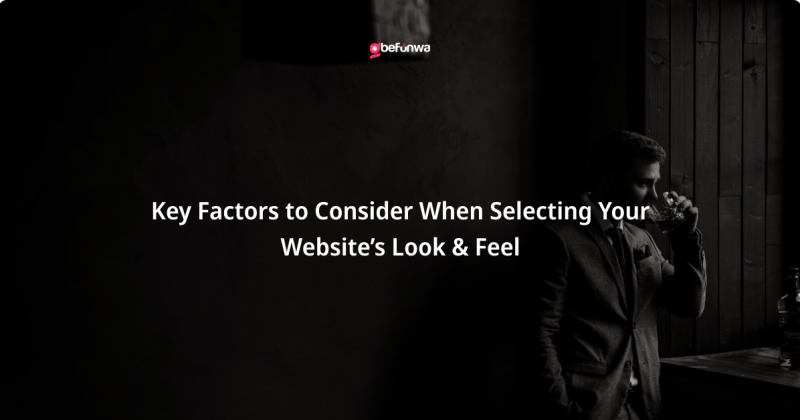
Your website’s look and feel play a crucial role in shaping visitors’ perceptions of your brand, influencing their browsing experience, and ultimately determining their actions. Whether you’re launching a new website or redesigning an existing one, selecting the right look and feel is crucial for achieving your business goals. Here are the key factors to consider when choosing the aesthetics of your website.
Before diving into design decisions, it’s essential to understand your target audience’s preferences, expectations, and behavior. Conduct market research, gather demographic data, and analyze user feedback to gain insights into what resonates with your audience. Tailor your website’s look and feel to appeal to their tastes and needs.
Your website should reflect your brand’s identity and personality to create a cohesive and memorable brand experience. Define your brand’s mission, values, voice, and visual elements, such as colors, typography, imagery, and tone. Ensure consistency in branding across all touchpoints to reinforce brand recognition and build trust with your audience.
Identify the primary objectives of your website, whether it’s driving sales, generating leads, increasing brand awareness, or providing information. Align the look and feel of your website with these objectives to guide users toward desired actions. Prioritize elements that support your goals while minimizing distractions that may detract from the user experience.
User experience is paramount in determining the success of your website. Prioritize usability, accessibility, and functionality to ensure a positive browsing experience for visitors. Design intuitive navigation menus, clear calls-to-action, and responsive layouts that adapt seamlessly to different devices and screen sizes. Minimize loading times and optimize performance to enhance user satisfaction.
Color plays a crucial role in evoking emotions, conveying messages, and influencing user behavior. Choose a color scheme that aligns with your brand identity and resonates with your target audience. Consider the psychological effects of different colors and their associations with specific feelings or meanings. Use color strategically to highlight key elements and create visual hierarchy.
Typography contributes to the readability, personality, and overall aesthetic of your website. Choose fonts that are legible across different devices and screen sizes, ensuring a comfortable reading experience for users. Select typefaces that complement your brand’s voice and convey the desired tone, whether it’s modern and minimalist or traditional and elegant.
Visual content, such as images, videos, and graphics, can capture attention, convey information, and evoke emotions more effectively than text alone. Use high-quality visuals that align with your brand’s style and resonate with your audience. Incorporate authentic imagery that reflects your brand values and connects with users on a personal level.
Strive for a balance between simplicity and complexity in your website’s design. Avoid cluttered layouts and excessive ornamentation that overwhelm users and detract from the main message. Embrace minimalist design principles that prioritize clarity, whitespace, and simplicity while incorporating subtle details and nuances to add depth and visual interest.
Ensure that your website’s look and feel are accessible to all users, including those with disabilities or limitations. Use accessible color contrast ratios, provide alternative text for images, and design with keyboard navigation in mind. Test your website across different browsers, devices, and screen resolutions to ensure compatibility and consistency.
Gather feedback from stakeholders, colleagues, and target users throughout the design process to validate your decisions and identify areas for improvement. Conduct usability testing, A/B testing, and user surveys to gather insights into user preferences and behavior. Use feedback to iterate on your design and refine the look and feel of your website iteratively.
Selecting the right look and feel for your website is a multifaceted process that requires careful consideration of your audience, brand identity, objectives, user experience, color scheme, typography, visuals, simplicity, accessibility, and compatibility. By understanding your audience, defining your brand identity, establishing clear objectives, prioritizing user experience, choosing appropriate aesthetics, balancing simplicity and complexity, ensuring accessibility and compatibility, and seeking feedback and iteration, you can create a visually stunning and user-friendly website that effectively communicates your brand message and achieves your business goals.
Deborah Oludimu is an experienced content writer with 3+ years of experience. She is skilled in research, writing, and editing to produce high-quality, engaging content across industries. Deborah is passionate about creating content that informs and inspires
© 2025 GBEFUNWA.COM. All rights reserved.
The WordPress® trademarks are the intellectual property of the WordPress Foundation, and the Woo® and WooCommerce® trademarks are the intellectual property of WooCommerce, Inc. Uses of the WordPress®, Woo®, and WooCommerce® names in this website are for identification purposes only and do not imply an endorsement by WordPress Foundation or WooCommerce, Inc. gbefunwa is not endorsed or owned by, or affiliated with, the WordPress Foundation or WooCommerce, Inc.